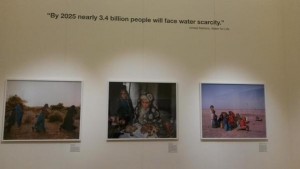 Luke Maxfield is an undergraduate student and GfGD Ambassador at Oxford University. Today he writes about a recent visit to a photography exhibition at Somerset House (London, UK) on the theme of Scarcity-Waste:
Luke Maxfield is an undergraduate student and GfGD Ambassador at Oxford University. Today he writes about a recent visit to a photography exhibition at Somerset House (London, UK) on the theme of Scarcity-Waste:
Upon entering the Syngenta Photography Award exhibition visitors are greeted with one of those worrying statistics:
“In the past 50 years, the world’s demand for natural resources has doubled. If we continue to use resources and generate waste at the current rate, by 2030 we will need the equivalent of two planets. But we only have one. Something needs to change.”
Unfortunately, such statements alone rarely seem to have the desired impact on the reader. The photography provides instead a visual means to provoke thought and discussion about global challenges. The exhibition at Somerset House in London, displays entries from 42 photographers – both professional and amateur – from 21 countries. All are interpretations of the theme: Scarcity-Waste.
The broad theme invited a comparison between the careless consumption in western countries with the daily struggle for the most basic necessities elsewhere. These problems are tied together by the ever-increasing strain on Earth’s climate and resources.
In every room of the gallery the relevance of the Earth sciences to such issues is clear. The photos referred to below can be viewed online at www.scarcitywaste.syngentaphoto.com.
Marco Garro’s ‘No home’ draws attention to the importance of sustainable mining. The image shows an open-pit copper mine in the middle of the Peruvian city Cerro de Pasco. The pit has been growing since the 1950s and has displaced thousands of surrounding residents. The mining activity has also resulted in the pollution of soil and nearby lakes.
Philippe Chancel’s ‘Ogoniland’ shows the oil stained water in the Niger Delta following two oil spills in 2008 and 2009. Again it is the local people who pay the price. The United Nations Environment Program found that sources of drinking water were contaminated with 900 times the acceptable of the benzene, a carcinogen. Despite these findings, new plans have been made to restart oil extraction in the region, without restoring the environment.
Other entries explored the effects of rising anthropogenic emissions. Shanghai’s skyscrapers are barely visible through the city’s own pollution in Benedikt Partenheimer’s ‘ShiziazHuang, AQI 360’ (the winner of the open competition). In the same room, we see the broader consequences, including extreme weather. Shocking images of the 2009 Kenyan drought by Stefano De Luigi show how the limited access to water takes its toll on all life in the region.
Another room deals with the issue of waste produced by developed countries. More statistics like ‘a third of all food produced is wasted each year’ are everywhere to be seen. These are put into visual context by Susana Raab’s ’Too Long at the Fair, McArthur Ohio’, which shows a bin overflowing with drink bottles and food packaging, and Gregg Segal’s ‘7 Days of Garbage – Michael, Jason, Annie and Olivia’, an image of a family lying in rubbish they produced in a week.
The winning entry of the professional competition provides a photographic study on water scarcity in Asia and Africa. Mustafah Abdulaziz’s work puts human faces to the ominous statistics written on the walls. This strong personal element is particularly clear in ‘Mariam Bakaule’, an image of an Ethiopian woman who walks for two hours to reach the nearest water source. The description below contains a quote from a villager which reads “water and women are synonymous here” – highlighting the fact that the burden of collecting water almost always falls upon the women and girls, reducing their ability to pursue work or education. Bringing people closer to sources of clean water is a step towards gender equality, as well as improving quality of life in the region. The contribution of hydrogeologists is vital in developing and managing groundwater resources.
The final room of the exhibition is named ‘Shaping Our Future.’ Jamey Stillings provides futuristic images of the Ivanpah Solar Power Facility in California. The plant is estimated to reduce CO2 emissions by roughly 0.4 Mt annually. Alongside are Claudio Rasano’s images of people who now make their living though recycling in South Africa. These are examples of the many opportunities presented by learning to live sustainably.
It can be difficult to convey the impact of global issues with bar charts and figures. The work exhibited at Somerset House provides alternative, more intimate way of doing so.
The exhibition can be viewed online at www.scarcitywaste.syngentaphoto.com and at Somerset House until 10th April 2015.

